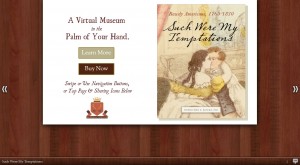When I got my PhD, I never pictured myself calling Jaclyn Penny at the American Antiquarian Society and saying, essentially, “You got any smutty stuff?” The result of my inquiries at AAS and other archives is now out: Such Were My Temptations: Bawdy Americans, 1760-1830. I’m writing about it here, on the AAS blog, because I’ve become an evangelist for using new tablet technologies to showcase rare-books art.

When I was researching the first American sexual revolution for my novel, The Glass Harmonica, A sensualist’s tale, I remember passing some black-and-white images buried deep inside a scholarly work. I read on, but then stopped – wait, was that really what I just saw? Turning back the pages, I peered at a (blurry, small) reproduced image of a shockingly explicit scene – from the 1790s.
Could I find a crisper image? Were there more? The unflappable Jackie Penny and other professionals I called at libraries and archives said, yes, indeed there were, and my project was off and running. I wanted readers to know the truth behind one of my characters, a rural bookseller who peddled Fanny Hill and more… shockingly more. I gathered what he would have sold out of the back of his carriage, and put it all together into a rich-media ebook.
Print technology in cash-strapped, academic presses cannot do justice to archival art. But rich-media ebooks can. Rich-media ebooks, briefly defined, are those you read on late-generation iPad, Kindle Fire, Nook HD, and other tablets. And now the content-creation programs for those tablets are becoming accessible to non-geeks – that is to say, people with modest technical skills.
For users of the AAS collections, this is fantastic news. With an asterisk. It’s almost fantastic news.
Using iBooks Author, released in 2012, you can easily create galleries of images – not to mention accompanying videos, music, interactive images, 3D items, and popover text like footnotes… Plus, in short order, I expect it’ll be easy to add zoom-able 3D timelines, interactive maps, and other rich media of particular interest to historians.
The downside of iBooks Author is that it’s only for Mac users and iPad owners. The asterisk is that it will be some time before a ‘device-agnostic’ program breaks down the walls between tablets. Technology changes so quickly that it could be just months away, and in fact, for those interested in pursuing the opportunities, frontrunners at the moment include Aerbook Maker, which helped develop my project. Others are Graphicly and Atavist, who likewise aim to make the process as easy as PowerPoint. Meanwhile, for those with more tech savvy, there’s Amazon’s KF8 and Adobe InDesign CS6.
Software details aside, the future is here. Extraordinarily luscious reproductions of historical images no longer are the purview of the few, the rare, the expensive coffee-table book. Such Were My Temptations is one example of a museum-in-your-palm. I’d like to read yours. For those wanting an introduction, I’ve created a how-to webinar series. You can find out more at BewareTheTimidLife.com.
Editor’s note: In the above video the author speaks from the heart about why she created a book about precursors to porn.

One thought on “New Use of Collections: Dorothee Kocks on Rich-Media eBooks”